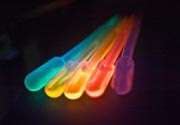Nano World: New aimed nanoparticles

A new method to develop collections of nanoparticles that each seek out different cell types could help scientists to better spot tumors before they grow or to deliver medicines to precise targets, experts told UPI's Nano World.
Interventional radiologist Ralph Weissleder at Harvard Medical School and his colleagues are developing nanoparticles that can emit either magnetic or optical signals. The hope is to coat these nanoparticles with compounds that help guide their way toward specific cells. Such coated nanoparticles could then single out tumor cells to help physicians detect where they are in the body, even if they are few in number and otherwise unnoticeable.
"The earlier you can detect cancers, the better your chances are for survival," said researcher Kimberly Kelly, a biochemist at Harvard Medical School in Charlestown, Mass.
Scientists are developing nanoparticles that carry medicines as well, Kelly said. Aiming such nanoparticles toward specific cells helps prevent side effects that arise from inadvertently drugging the wrong cells.
Weissleder and Kelly and their colleagues developed a new method to both rapidly coat nanoparticles with any of a number of small molecules and rapidly screen the resulting nanoparticles against various cell types to see which coatings work best. "Small molecules are easier to synthesize and cheaper than, say, peptides," Kelly said, which scientists are experimenting with also as nanoparticle coatings.
The researchers started with fluorescent magnetic nanoparticles and used robots to link 146 different kinds of small molecules demonstrating a variety of molecular binding affinities to these nanoparticles, for roughly 60 small molecules per 38-nanometer-wide particle. The scientists next tested these nanoparticles against five different kinds of human cells, including pancreatic cancer cells and cells known as macrophages, which engulf germs and debris.
The researchers found nanoparticles that specifically went after pancreatic cancer cells. They also found nanoparticles that far preferred activated macrophages -- those that avidly hunt down targets -- to resting macrophages. Specific kinds of activated macrophages are linked to autoimmune diseases and the atherosclerotic plaques associated with artery clogging, Kelly explained.
"At the very early stages, it is very difficult to detect atherosclerotic plaques when they are developing," said chemist and magnetic nanoparticle researcher J. Manuel Perez at the University of Central Florida in Orlando. "So this could be important for that."
Depending on which coatings they used, the scientists also found they could vary how many nanoparticles the cells took up, from roughly 11,000 per cell to 5.5 million, which could prove useful if scientists want to precisely meter out how many drug-loaded nanoparticles reach targeted cells. The researchers presented their findings in the November issue of the British scientific journal Nature Biotechnology.
"The high-throughput assay they demonstrate is a very important path of research," Perez said. "The more diversity you have with these nanoparticle surfaces, the more chance that you have of having a hit against a specific receptor over-expressed in disease."
The researchers have expanded their chemical library to include another 96 kinds of small molecules and hope to soon branch out more "to make our technique more effective," Kelly said.
Copyright 2005 by United Press International
















